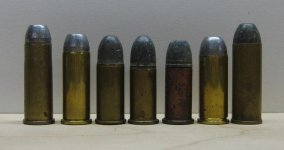Howdy
Since you are in the antique section, the answer is quite simple. The cylinders of the early Number 3 frames were not long enough to accommodate the 38-40 or 44-40 rounds. The first large frame round chambered by a S&W revolver was the 44 S&W American round. A relatively short round compared to such rounds as 38-40, 44-40, and 45 Colt. The cylinder was long enough to accommodate the 44 S&W American round, there was no need to make it longer. When the Russian model was developed, the 44 Russian round was almost the same as the 44 American round, the difference was the 44 American round used a heeled bullet, the 44 Russian round used a bullet that fit inside the case.
The whole reason the 45 Schofield round was invented was because the cylinder of a Number 3 frame was not long enough to chamber the 45 Colt round, so S&W was allowed to submit the Schofield model to the Army trials with the shorter Schofield round. S&W never sold a great deal of Schofields to the Army, no where near as many as Colt sold. It has often been speculated that the reason the Army declared the Schofield model surplus by 1880 is because of supply problems with ammunition. The Colt Single Action Army could chamber either the Schofield ammo or 45 Colt. But the Schofield model could only chamber the Schofield ammo. I have never seen any proof of this, but it is often speculated that some units that were issued the Schofield revolver may have gotten 45 Colt ammo shipped to them that they could not use.
When the New Model Number 3 came out it was most often chambered for the 44 Russian round. It was also chambered for a variety of other rounds that would fit in its relatively short cylinder. It was the New Model Number 3 that was finally chambered for 38-40 and 44-40, but this could only be done with a special model that had a lengthened frame and cylinder to accommodate the longer rounds. The 44 Double Action was also made in a version with a longer cylinder that could chamber the 38-40 and 44-40 rounds.
I have included a photo that illustrates the relative lengths of some of these cartridges. Left to right the cartridges are 44-40, 44 Special, 44 Russian, 44 S&W American, 44 Henry Rimfire, 45 Schofield and 45 Colt.
As far as handejectors are concerned, I suspect it was simply that S&W was very jealous of the cartridges they developed and wanted to promote them. Just speculation on my part. The words 38 S&W Special and 44 S&W Special are only marked on S&W revolvers. Other companies simply mark them as 38 Special or 44 Special. When the Triple Lock came out, it was the first revolver to be chambered for 44 Special. 44 Special was about a tenth of an inch longer than 44 Russian. Oddly enough, the ballistics were the same. The cylinder of the Triple Lock was long enough to chamber the 44 Special round as well as the slightly longer 38-40, 44-40 and 45 Colt rounds. Since the Triple Lock was the first of the N frame revolvers, all the N frames that followed would be large enough to accommodate those three rounds.
I tend to agree that 38-40 really had no purpose. Winchester developed the 44-40 round for the Model 1873 Winchester. Previous models had chambered the shorter and less powerful 44 Henry Rimfire round. Winchester developed the 38-40 round and it became the second chambering available for the Model 1873 in 1879. The 38-40 is really just a 44-40 necked down to 40 caliber. It is anybody's guess why they did not call it the 40-40. Ballistically it is very similar to 44-40. If you look at sales for the Model 1873, they were starting to dip a bit. I suspect Oliver Winchester simply was trying to sell more rifles to a market that was already becoming saturated by offering a new chambering. Winchester was a very clever entrepreneur.
As far as the tapered cartridges wedging themselves back in a revolver chamber, I recently read some evidence to support that. However, Colt had chambered the Single Action Army for 44-40 by 1878 and it was the second most popular chambering for the SAA, second only to 45 Colt. The SAA was chambered for 38-40 in 1884 and it was the third most popular chambering. So clearly, Colt had solved any problems with spent cases backing out and binding up the cylinders.

